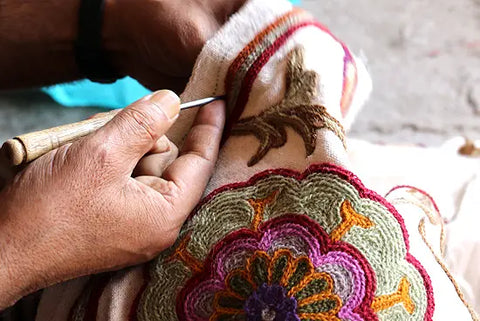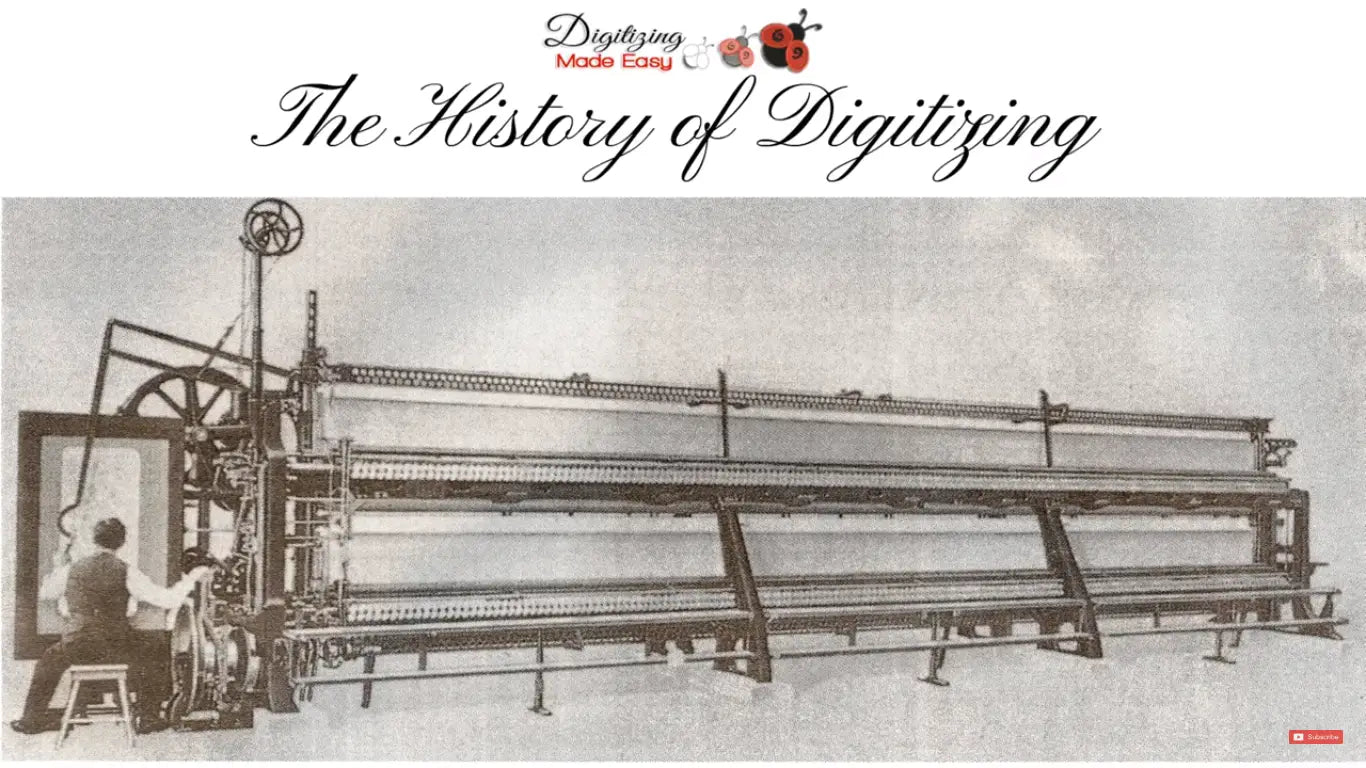In today’s era, when the world is consumed by mechanical technologies, and where the outcomes lead to machinery completing most of our tasks and projections, there are still a few people and cultures that are keeping the art of handmade creations alive.

{Image source - D'source}
Embroidery is one such treasure cove of arts that has been handmade and cultivated for centuries on end. Although in recent times, machinery has taken the load off the workers, the handmade embroidery designs works are much more appreciated as they reflect on the hard work and passion portrayed by the artisans in making them.
In a country like India, where there are a number of states, each with different customs and generational outfits and clothes, there is an array of hand thread work embroidery designs varied embroidery. The works are representative of the flora, and fauna as well as folk depictions, and are the imagery of nature and the past of the community.

{Image source- The better India}
Here, we delve deep into the fabulous art of intricate embroidery and the multiple branches of it in the world.
What is Thread Work?
The art of intricate threadwork involves using thread to create motifs and designs on fabric and other surfaces. This beautiful art form is ancient and uses versatile techniques across cultures and centuries. One of the most popular kinds of threadwork is embroidery where intricate designs and motifs are made using colourful threads on fabric. With unique styles and techniques, embroidery designs historically have been inspired by nature, wildlife and culture. While some designs can have motifs like flowers, leaves or animals, some can be as descriptive as having tales from Ramayana depicted on fabric.
This decorative art form has practical uses too. Embroideries can strengthen a fabric, add warmth, or make functional clothing items.
Other kinds of work with threads include macrame, Kumihimo, crochet and knitting.
India is a land of varied cultures with their own history and legacy. Many regions of India has their unique hand thread work embroidery designs.
Types of Thread Works Found in India
India with its rich cultural history is the land of numerous kinds of hand thread work embroidery designs. From delicate embroideries like Chikankari of Lucknow to the ornate kantha stitch or ‘nakshikantha’ of Bengal, each region of India has popular embroidery designs. Let us look at some of the famous art of intricate embroideries in the country.
Kutch Embroidery
One of the most well-known forms of thread work is hand embroidery of Kutch, Gujarat. Kutch embroidery uses multi-coloured threads and stitches, and is done with the intention of making patterns on the cloth with the help of needles. An unknown fact about this hand thread work embroidery design is that the motifs were originally an inspiration by the Mughals, and have since been carried on through the years by the locals of the state.

{Image source- Indian eagle}
Traditionally practised on long skirts worn by the women of the region, and household objects such as torans, it had progressed into the world of fast fashion and is used in making bed sheets, kurtas, sarees, and other clothing items. Embroidery and the art is one of the widest sources of income for the artisans and is a major point of their livelihood and daily activities.

You can check Kutchi embroidery products available on iTokri.com from here-
https://www.itokri.com/collections/kutchi-embroidery
Crewel Embroidery
Another famous form of embroidery is the Crewel embroidery patterns, which are known for their big, bold, and colourful designs made from wool threads. The use of wool or yarn threads, and the use of 2-ply wool thread, which is called crewel, give this form of thread work its name.
It is known to be unique stemming from the art form representing large and old motifs, usually stitched on cushions, curtains, tapestries, and now even clothing items. Dating back to the medieval era, the oldest known crewel work piece was around a thousand years back, named the Bayeux Tapestry which was originally made in England but then given to the country of France. The most common kind of fabrics used for the embroidery base is linen twill and linen materials, which have a close weave and help keep the larger crewel wool stitches in place while designing. The Indian base for this branch of embroidery is in Kashmir, where crewel is often practiced, using “aari”, the hook and woolen yarns are either white or multicolored shades.

{Image source- wordpress}
Chikankari Embroidery
Next, from the city of Lucknow, we have the Chikankari or Chikan form of embroidery, which had been made popular in India by the Mughal queen Noor Jahan. Originally done only on white cloth, with white thread embroidery, today these unique hand thread work embroidery designs are available in almost all the colours of a palette.
Chikan art is done by threading traced patterns on materials like muslin, chiffon, or even silk materials, to depict designs and motifs.

Gota Embroidery
Another form of embroidery that has its roots in the same city of Lucknow, is Gota. Birthed in the state of Rajasthan, the technique of embroidery uses “zari” from Lucknow to etch the patterns on fabrics such as georgette or bandhani. Giving an elegant and royal look to the clothes, Gota is used to make suits, dupattas, ghagras, and other ethnic styles.

Kantha Embroidery
West Bengal, Odisha, and other East Indian states are known to have expertise in Kantha embroidery, which is most commonly performed by rural women of the states. Engraving motifs of flora, fauna, geometric patterns, and celestial objects as well. Done by forming a wavy and wrinkly effect, it works on cushions, blankets, bedspreads, and now even shirts for men and women. Giving the look and feel of leisure, it also appeals to a rich “karigari” and embroidery on the fabrics.

Phulkari Embroidery
Phulkari embroidery from Punjab is another famous form of this art in India, and was known extensively for its mention in the folklore of “Heer Ranjha”. Embroidering with bright colorful designs and threads on dull, usually khadi cloth fabrics, most motifs are geometric patterns or nature-centric and are accentuated by horizontal, vertical, and diagonal line patterns. Embroidery is the art of decorating and adorning fabrics with threads and decorative yarn and has been in existence since the production of fabric, in one way or another.

Having spoken extensively about the handmade and intricate works of artisans above, we now come to the embroidery done by machines and mechanical tools. Machine embroidery is the process of sewing and using the same machine for creating designs and patterns on fabrics. It is widely commercial and used in today’s generation of growing fashion trends and demands. Along with being used in the fashion and clothing industry, these methods are also used by progressing artisans and small artist businesses to assist them in the task of embroidery, as well as amateurs or individuals interested in the art, of making and creating patterned pieces.

{Image source- Rizwan Ali (youtube)}
The first instance of machine embroidery was in 1964 and created by Tajima, and they started selling it as the “TAJIMA Multi-head Automatic Embroidery machines”. Over the years, many other companies kept working on the original model and added newer and more advanced techniques, such as circle stitching and satin stitches, electronic machines as well as heater wire machines.

There are three types of machine embroidery, the first being free-motion machine embroidery. The designs are created by using a zig-zag sewing method and are used primarily for tailoring as it lacks some of the specialized tools for more expert designs and patterns. The second of this kind is the Cornely hand-guided embroidery, which was created in the 19th century, and is used mainly to curate the Beauvais stitch or the chain stitch.
The last type of machine is computerized machine embroidery, which is computer controlled and made with the sole focus to help with embroidery tasks. Today’s age sees a varied and in demand usage of embroidery machines, as opposed to earlier times, owing to the massive increase and upward slope in the demand of fashion, fabrics, and textiles in the industry.
Most local artisans may not be able to keep up with the demand, as the art of handwork and intricate thread work are time consuming and require huge focus and a qualitative amount of time. Most artisans from remote villages and cities may not even be able to afford the machines, which in today’s time range from Rs.10,000 to Rs.50,000 roughly.
However much the machines may take over the world, the purest and most intricate methods of thread work are done by the hands and labored hours of the original embroiderers and artists, and will forever be one of the most skilled and efficient, economical talents of the people of India.
Frequently Asked Questions
What are the 5 types of embroidery?
There are various types of hand embroideries found in India. Some of the famous embroideries are Chikankari from Lucknow, Phulkari from Punjab, Kantha from West Bengal, Crewel Embroidery from Kashmir, Kutch embroidery from Kutch, Gujarat.
How do I create my own embroidery design?
You can draw your design on lightweight tracing paper. Tape the tracing paper to a light box or a bright window. Place the fabric on the other side, and use a felt pen to re-create the design. Once the design is on the fabric you can use colourful threads to make your embroidery design.
Written by,
Nishtha Lall
Blogs you might also like:
Madhubani Paintings - A Brief Story of the Art
Sanganeri Chapai - The Ancient hand block printing Art
Significance of Wearing Nose Pins
 Verified Purchase
Verified Purchase















Leave a comment (all fields required)